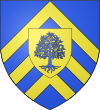Deurne, Belgium
| Deurne | ||
|---|---|---|
| District of Antwerp | ||
|
||
 District of Deurne within the city of Antwerp |
||
| Country |
|
|
| Region |
|
|
| Province | Antwerp | |
| Municipality | Antwerp | |
Deurne ([ˈdøːrnə]) is the second largest district of the municipality of Antwerp, Belgium, (right after the Antwerp town district) and has 69,408 inhabitants.
Deurne is best known for its green environment with the biggest park in Antwerp Rivierenhof.
During the Ancien régime Deurne was nothing more than part of the Eastern hinterland of Antwerp. Like many dwellings it settled on the crossroads of a river (the Schijn) and a connection route (the 'Turnhoutse baan': the road from Antwerp to Turnhout). There are indications that Deurne existed in prehistoric and Roman times but the first tangible proof of Deurne only dates back to 1185.
Deurne consisted mainly of sparsely populated farmland. However, as a direct result of the increasing wealth of the Antwerp population, many estates were erected (the so-called "Hof van Plaisantie" was a specific rural estate, a bourgeois version of a château or country house). Typically, merchants, diplomats, wealthy artists (like Peter Paul Rubens f.i.) would escape to their Hof van Plaisantie. Some country houses in Deurne were : Sterckxhof, Papenhof, Lakbors, Bisschoppenhof, Gallifort, Inkborsch, Bosuil, Ertbrugge & Venneborg. Although most country houses were destroyed over the centuries (especially in 1542), some like Sterckxhof or Bisschoppenhof survived. Further surviving evidence of this aristocratic history of Deurne is the St Fredegand Church and the adjacent cemetery (the St-Fredegandusbegraafpark).
After the battle of Waterloo William of Orange started to connect the Antwerp port with its hinterland through the construction of a series of canals between Antwerp and Liège, connecting the Scheldt with the Maas. Although work started under his reign in 1823, work wasn't completed until 1874.
...
Wikipedia

